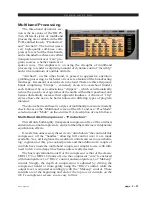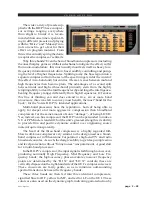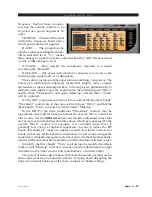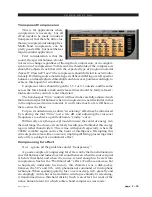
V O R S I S H D P 3 G U I
page 2 – 15
HD P3 / Aug 2006
De-Esser
The de-esser is a dynamic equal-
ization section, designed to restrict
the output level of a chosen fre-
quency range within the spectrum.
The classic usage is to hold down
the sometimes prominent and ob-
jectionable sibilant “hissy” noises
in speech, particularly if poorly re-
corded or subject to poor or overly
close microphone technique. It is
also often used to help control the
“honky” effect on phone lines; mer-
cifully, with digital phone systems
this is less of an issue than it once
was, but it still crops up. The con-
trols are:
THRESH — Threshold is the
signal level (within the de-esser’s controlled bandwidth) at which the de-
esser holds the output level, again, within the de-esser’s bandwidth. In
other words, a signal within the de-esser’s band will not be allowed to
exceed this threshold level.
ATTACK — The time-constant controlling how quickly the de-esser
responds to a signal exceeding the threshold.
RELEASE — The time-constant controlling how long the de-esser
takes to recover from a signal that has exceeded the threshold.
FREQUENCY — This is the center-frequency of a filter which
determines the band of frequencies over which the de-esser operates. It is
operated in conjunction with . . .
BANDWIDTH — ... which determines how wide on either side of the
center-frequency the de-esser is sensitive.
The de-esser screen on the GUI brings up a graphical representation on
the big frequency-domain graph of the de-esser’s filter, as controlled by
“Frequency” and “Bandwidth”; the 3dB-bandwidth of the filter is ar-
ranged to be at the center-line of the graph for easy visualization.
Particularly when the input signal spectral analysis is being displayed, it
is often easy to visually “tune in” the de-esser to the visual clues of the
objectionable sound on the analyzer.
Once the threshold within the de-esser’s band has been broached, an
“inverted shark’s fin” reaches down from the top of the frequency-domain
graph, indicating the width in frequency and depth of attenuation due to the
de-esser.
Regardless of the visual clues available thanks to the GUI, the most
direct way of tuning in the de-esser is the old-fashioned way - by ear. Make
the “Bandwidth” small, narrow; crank down the threshold (i.e. make it
more sensitive), then carefully tune the “Frequency” until the undesired
artifact is getting audibly affected. Careful (!) adjustment of “Bandwidth”
















































